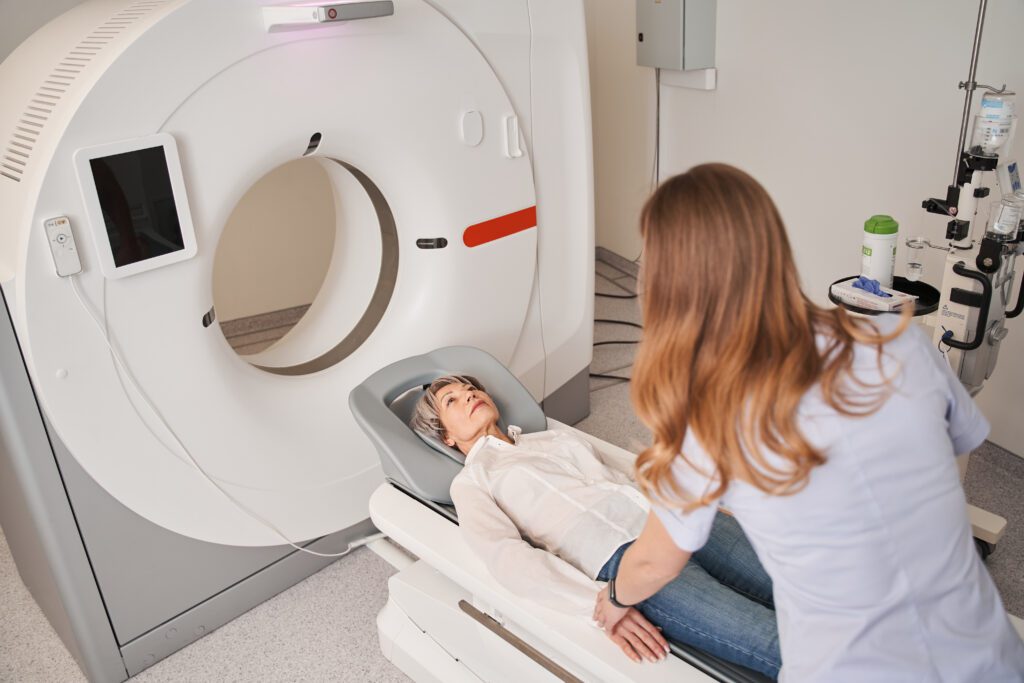When your healthcare provider suspects you might have cancer, they may order a CT scan.
Your healthcare provider ordered a CT scan because they want a series of detailed, high-resolution images of your organs and tissues, so they can get a clear look at any areas of concern.
That’s because a CT can easily detect bladder cancer, colorectal cancer, kidney cancer, ovarian cancer, and other kinds of cancer.
We’ll help you understand when a CT scan is the best choice for detecting cancer, why your provider recommended it, and what kinds of cancer a CT scan can detect.
When is a CT scan the best choice for detecting cancer?
CT scans can be a good choice for detecting cancer when a healthcare provider suspects it might be present in a specific organ, such as the lungs, liver, or kidneys. CT scans are also used in colorectal cancer screenings, lung cancer screenings, and screenings for other types of cancer.
CT scans and early cancer detection
CT scans are a helpful tool in early cancer detection because they can provide detailed cross-sectional images that help healthcare providers identify suspicious masses or tumors. They can also show a tumor’s size, shape, location, and mass, helping healthcare providers determine if a growth is potentially cancerous.
A CT scan can also help determine the extent or severity of cancer, and whether it has spread to other parts of the body, which can help your provider decide the most effective course of treatment.
How accurate is a CT scan for early cancer detection?
CT scans are highly accurate in detecting some cancers at an early stage. They can also be used to monitor the size of tumors during treatment to determine if your treatment is working.
What tests have limitations in detecting certain cancers?
Other diagnostic tests, such as blood tests and X-rays, can be helpful in diagnosing certain kinds of cancers, but both have drawbacks.
Blood tests
Blood tests can indicate the presence of cancer cells in the body, but some kinds of cancer may not produce detectable blood markers, leading to false negatives. Additionally, abnormal results in a blood test may not always indicate cancer, as other conditions can also cause changes in blood markers.
X-rays
X-rays are useful for detecting abnormalities in the body, such as tumors or masses, but they may not provide detailed enough images to confirm a cancer diagnosis. X-rays can also miss smaller tumors or may not be able to differentiate between cancerous and non-cancerous growths.
What cancers can a CT scan not detect?
Some cancers, especially those involving soft tissues or small tumors, are difficult for a CT scan to read. There are other cancers CT scans have difficulty detecting, such as brain cancer in certain locations, pancreatic cancer in its early stages, blood cancers like leukemia, bone cancers like multiple myeloma, or cancers in very small or hidden areas. It is important to consult with a healthcare provider to determine the most appropriate diagnostic scans for detecting specific types of cancer.
Why did my healthcare provider recommend a CT scan for detecting cancer?
Your healthcare provider likely recommended a CT scan because you’re experiencing symptoms they think a CT scan could help them to understand. Also, your healthcare provider has already considered any possible family history of cancer, and other risk factors like obesity or smoking.
Other factors to consider for detecting cancer
CT scans provide highly accurate, high-resolution images of organs and tissues, images your provider needs to assess your condition and whether or not you have some kind of cancer. There are also other important factors:
Your family history
Your family history can play a crucial role in the early detection of cancer. A CT scan, combined with knowledge of your family history, can help your healthcare provider detect any cancer you may have at an earlier stage.
Other risk factors
Other risk factors for cancer include tobacco use, diet, and alcohol use. Being overweight can also increase the risk of cancer.
CT scans and radiation exposure
CT scans do emit some X-ray radiation, but the levels of radiation are well within safe amounts, and the benefits of accurate cancer detection often outweigh any risk associated with the radiation from a CT scan.
What to ask your provider before a CT scan if pregnant or trying to conceive
If you are pregnant or trying to conceive, your healthcare provider may advise against a CT scan because the radiation may be harmful to you and your baby. If you think you are pregnant, check with your healthcare provider before you have a CT scan; they may suggest other imaging options.

What kinds of cancer can a CT scan easily detect?
With the help of your CT scan results, your healthcare provider can easily detect bladder, colorectal, kidney, ovarian, and stomach cancer. Let’s take a closer look at how a CT scan can find each kind of cancer.
Bladder Cancer
How CT scans detect bladder cancer
CT scans can detect bladder cancer by using X-rays and a computer to create three-dimensional, cross-sectional pictures of the bladder, as well as the ureters and kidneys. A CT scan may be used to see whether bladder cancer has invaded the bladder wall, or has spread to other organs or nearby lymph nodes.
What to expect from a CT scan for bladder cancer
A CT scan for bladder cancer, also known as a CT urogram, is a painless procedure that uses X-rays to create cross-sectional images of the bladder, kidneys, and ureters. The scan can help doctors assess the urinary tract’s function and identify signs of bladder cancer, such as tumors, thickened bladder walls, or bleeding.
During a CT scan for bladder cancer, you will lie on a table that slowly moves into a donut-shaped structure called a gantry. A motorized X-ray source rotates around inside the gantry, sending narrow beams of X-rays through your body for short periods of time. The X-rays are absorbed by the body’s tissues and detected by the scanner, which transmits the information to a computer. The computer then transforms the information into images that a technologist can interpret.
Colorectal Cancer
How a CT scan finds colorectal cancer
To detect colorectal cancer, the CT machine will scan the area around your midsection. This scan can determine whether colorectal cancer has spread to nearby lymph nodes, the liver, lungs, or other organs.
Kidney Cancer
How CT scans find kidney cancer
Using the same technology as other CT imaging scans, a CT scan can help diagnose kidney cancer by using X-rays to create cross-sectional images of the abdomen and kidneys. A CT scan can help healthcare providers determine the size, shape, and location of a tumor, and whether the cancer has spread to other parts of the body. CT scans can also be used to help guide biopsies and local treatments.
Ovarian Cancer
How a CT scan detects ovarian cancer
CT scans can help identify ovarian cancer, including masses, tumors, or excess fluid in the abdomen, which can increase the likelihood of ovarian cancer. A CT scan reveals an ovarian cancer tumor’s size and whether the cancer may have spread to other organs, like the bladder, kidneys, or lymph nodes.
Stomach Cancer
How CT scans find stomach cancer
CT scans can pinpoint stomach cancer’s location well, often confirming the cancer’s suspected location. CT scans can also show other parts of the body to which stomach cancer might have spread, such as the liver and nearby lymph nodes.
How to schedule a CT appointment with American Health Imaging
Reach out to us at American Health Imaging, and we’ll help you schedule an appointment at an imaging center near you, today.
We’re here to help you get the answers you need.
Frequently Asked Questions About CT Scans and Cancer Detection
A CT scan is often the best choice for detecting cancer when detailed images of internal organs and tissues are needed for accurate diagnosis.
CT scans are highly accurate for early cancer detection, providing detailed cross-sectional images that help identify tumors at their earliest stages.
Blood tests and X-rays may not always provide the detailed images necessary to detect certain cancers, which is why a CT scan is sometimes preferred.
Your healthcare provider may have recommended a CT scan based on your family history, other risk factors, or symptoms to get a clear and detailed view of potential cancerous areas.
What should I ask my provider if I'm pregnant or trying to conceive and need a CT scan?
CT scans contribute to early cancer detection by providing high-resolution images that can reveal tumors at their earliest, most treatable stages.
Yes, some cancers, especially those involving soft tissues or small tumors, might be difficult to detect with a CT scan, and other imaging methods might be necessary.
